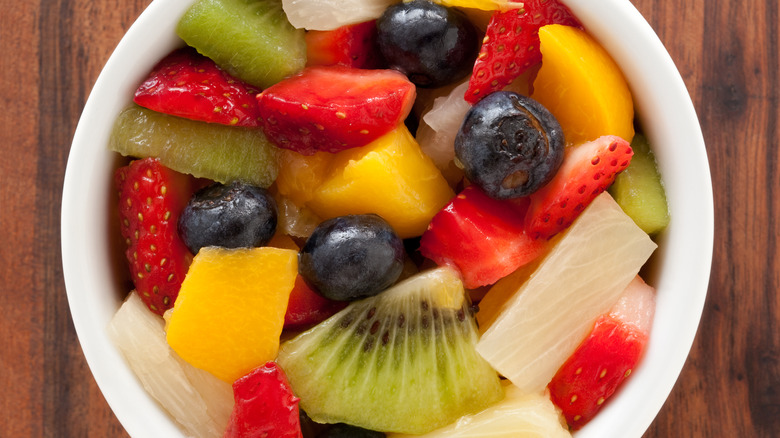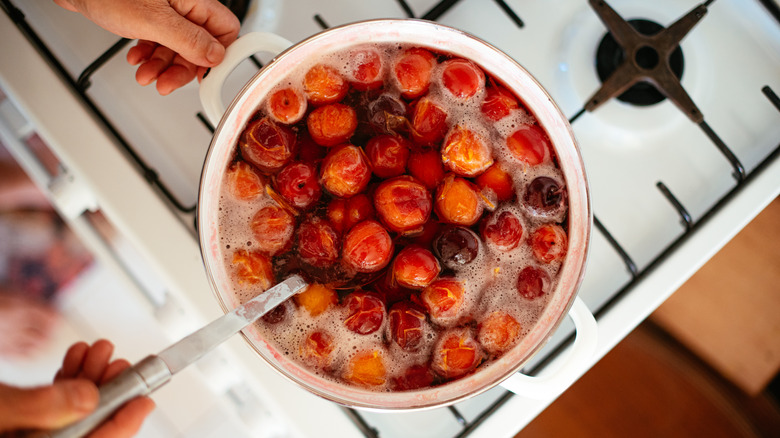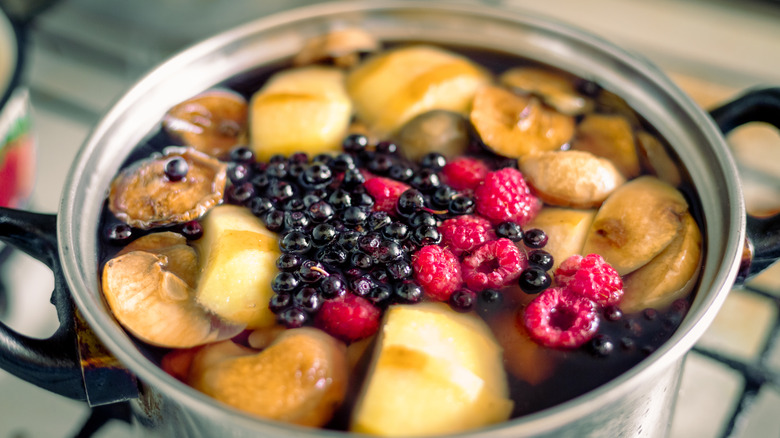Hot Fruit Salad Is The Perfect Cozy Treat For A Cold Night
From the creamy, marshmallow-specked ambrosia salads of the southern United States to the jelly-like Japanese dessert anmitsu, one common denominator typically unites fruit salads from around the world: the serving temperature. Fruit salads are usually considered summer fare and served cold. But when winter rolls around, why not defy convention with a warm and cozy take on the classic?
You can make an old-fashioned hot fruit salad in your slow cooker as a comforting side dish to a roast or as a dessert topping for pound cake and other sweets. It takes shelf-stable fruit, including canned peaches and pears, chunky applesauce, and dried apricots and cranberries, and marries them with warm spices such as cinnamon and nutmeg. Together with butter, sugar, and salt, the ingredients simmer in the slow cooker for a couple of hours until the fruit is soft and plump and the liquid is syrupy and fragrant.
Of course, you're not required to stick to a recipe if you want to make a hot fruit salad on a cold winter's night. Here are some ideas to inspire your next fruity slow-cooker or stovetop experiment.
What's in season?
Warming up a mix of canned and dried fruits is the most common way to make an autumnal or wintry fruit salad, but you can use fresh fruit if you prefer. If you opt for fresh fruit, consider what's in season. Fall fruit harvests might yield apples, cranberries, quince, figs, grapes, key limes, and pears; whereas mid-winter markets might be flush with citrus fruits and pomegranates. Undrained canned fruits have enough liquid to cook in; you might have to add water or another liquid to fresh fruits prior to cooking.
After you choose the fruit you want to use, select spices that will add a warm, seasonal flavor profile. Cinnamon sticks, cardamom pods, dried or fresh ginger, star anise, cloves, and vanilla beans are traditionally welcomed in a variety of festive holiday recipes and are ideal for flavoring a warm fruit salad.
Once you decide on the base of your fruit salad, think about texture, just as you would for a green salad. This might mean reserving a bit of uncooked fruit to mix in at the last minute — think poppable pomegranate seeds, chunks of fresh apple, halved grapes, or go all out and make pears poached in red wine. Adding texture can also include non-fruity ingredients such as toasted nuts or seeds. A bit of crunch will play nicely with the softened fruit.
A hot fruit salad or a compote?
Should you ever run out of ideas for tasty ingredients to put in your hot fruit salad, try drawing inspiration from the dish's more established sibling, stewed fruit, also known as compote. In preparation, ingredients, and levels of comfort, the two are strikingly similar. The main difference? Compote, a French term that refers to fruit that's been stewed in sugar, syrup, and spices, has been around for a lot longer. Historians trace the origins of the dish to medieval Europe, though back then it was more commonly referred to as breney.
Compote recipes often call for a mix of fresh and dried fruit, the latter of which rehydrates and plumps up during the cooking process. When making a hot fruit salad inspired by compote, you might also find yourself reaching for your favorite liqueur, such as brandy or Grand Marnier, to add to the mix. Fresh or frozen orange juice, another common compote add-in, would also work wonderfully in a hot fruit salad. At the end of a cold day, there's comfort and warmth in a hot fruit salad by any name.


